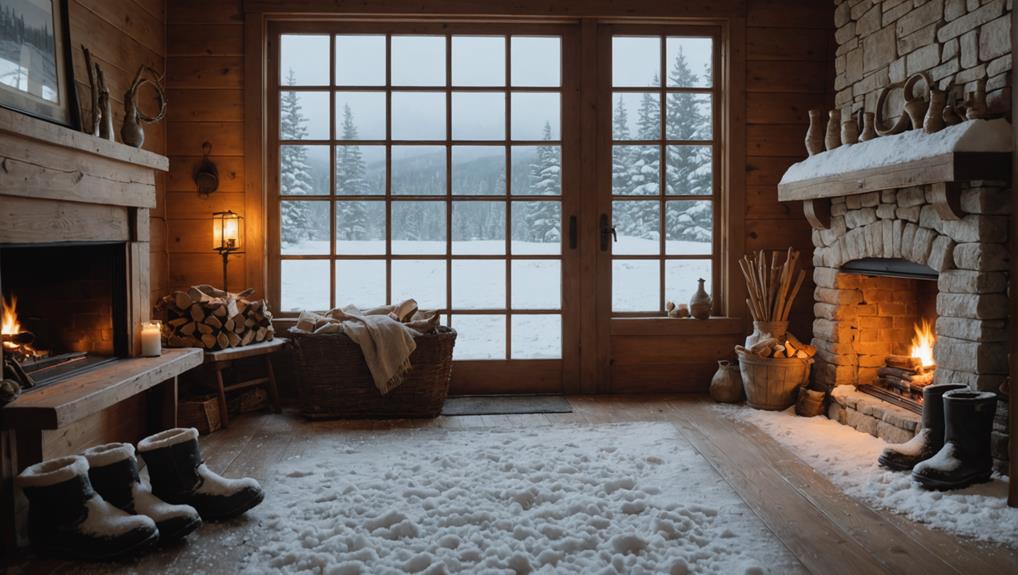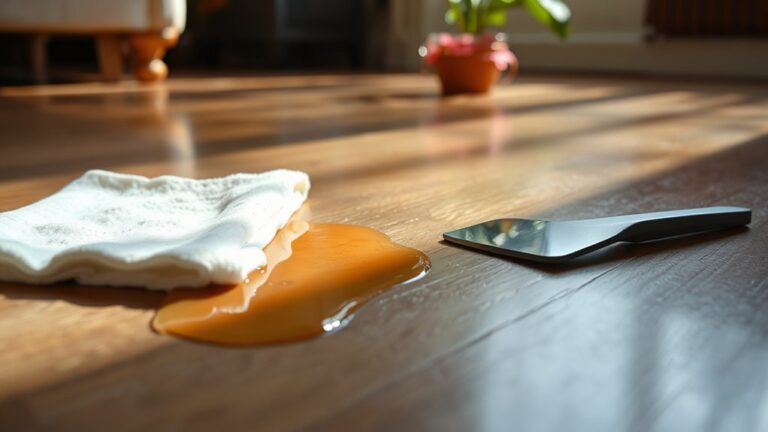To protect your floors this winter, focus on moisture and salt management. Use quality mats at entryways to trap snow and absorb water, which helps prevent warping and damage to hardwood or laminate. Ceramic or porcelain tiles are ideal for high-traffic areas due to their water resistance. Regularly check and replace worn mats, and encourage guests to wipe their shoes before entering. Clean floors with a mild detergent and use microfiber mops to remove debris. Taking these preventative steps now will save you from costly repairs later. There's more you can do to keep your floors safe all season long.
Understanding Floor Damage Risks
Winter brings a unique set of challenges for your floors, with potential damage lurking around every corner. One of the primary vloeren vulnerabilities during this season is moisture absorption. Snow, ice, and water tracked in from outside can seep into your flooring materials, leading to warping, swelling, or even mold growth. This is especially true for hardwood and laminate floors, which can suffer irreversible damage if not properly protected.
To minimize these risks, it's essential to establish a proactive care routine. Start by placing mats at your entryways to catch excess moisture and debris. Encourage family and guests to wipe their feet thoroughly to prevent water accumulation on your floors. You might also consider using area rugs in high-traffic zones, providing an extra layer of protection.
In addition to moisture, be aware of the harmful effects of salt from de-icing products. Salt can scratch and dull the finish of your flooring, leading to further vulnerabilities. If you use salt on your walkways, make sure that you clean up any residue that makes its way indoors quickly.
Regularly monitoring and maintaining your floors is key to safeguarding them from winter's harsh conditions. Check for any signs of moisture damage or wear, and address issues immediately to prevent further deterioration. By taking these simple steps, you can guarantee your floors remain safe and beautiful throughout the winter months.
Choosing Durable Flooring Materials
Selecting the right flooring materials can make a significant difference in your home's resilience during the colder months. With snow, salt, and water constantly tracked in, choosing durable options is essential for maintaining safety and longevity.
When considering tile options, ceramic tiles stand out for their water resistance and ease of cleaning. They're perfect for entryways and kitchens where moisture is often a concern. Additionally, porcelain tiles offer a durable alternative that can withstand heavy foot traffic.
If you're leaning towards carpet choices, opt for those made from synthetic fibers, which are generally more resistant to moisture and stains. Look for carpets with moisture-wicking properties that can help keep your home dry and reduce the risk of mold.
For those who love the warmth and aesthetics of wood, hardwood alternatives like engineered wood can provide similar beauty with added durability. These materials are more resistant to changes in humidity, making them a solid choice for winter months.
Lastly, don't overlook the vinyl benefits. Luxury vinyl planks and tiles are incredibly resilient against water damage, making them an excellent option for any area of your home. They can mimic the look of wood or stone while offering better resistance to moisture and spills.
Preventative Measures for Winter
As the colder months approach, taking preventative measures for your flooring can save you from costly repairs and maintenance down the line. One of the most effective steps you can take is to invest in quality floor mats. Placing these mats at entry points not only helps trap snow and salt but also absorbs moisture, greatly reducing the risk of water damage to your floors. Choose mats designed specifically for winter conditions, as they offer better durability and absorbency.
In addition to floor mats, installing moisture barriers can further protect your flooring. These barriers are especially essential in areas prone to water exposure, like entryways and basements. A moisture barrier acts as a shield, preventing water from seeping into your flooring material, which can cause warping or mold growth.
Make it a habit to regularly check and replace worn-out mats to guarantee maximum effectiveness. Also, encourage family members to wipe their shoes thoroughly before entering your home. This simple action can drastically minimize dirt and moisture brought indoors.
Effectieve reinigingstechnieken
Maintaining clean floors during winter is just as important as taking preventative measures. With snow, salt, and water tracked inside, your floors can quickly become a hazard. Effective cleaning techniques can help you keep your home safe and tidy.
Start by choosing the right cleaning solutions. For hard surfaces, a mild detergent mixed with warm water works well. Avoid harsh chemicals that can damage your floors or leave residues. For carpets, consider a carpet cleaner designed for winter stains, like salt or mud. Always test any solution in a small area first to verify it won't cause discoloration.
Next, focus on your mop techniques. Use a microfiber mop for hard floors; it attracts dirt and moisture effectively. When mopping, work in small sections, applying the cleaning solution and allowing it to sit briefly to break down grime. Then, mop up the excess moisture to prevent slipping hazards. Remember to rinse your mop frequently to avoid spreading dirt around.
For carpets, use a vacuum with a strong suction to pick up salt and debris. If spots remain, gently scrub them with a damp cloth and your chosen cleaning solution. Blot, don't rub, to prevent spreading the stain.
Regularly cleaning your floors will not only enhance their appearance but also guarantee a safe environment for you and your family. By employing these effective cleaning techniques during winter, you're taking a proactive step toward maintaining a safe and welcoming home.
Long-Term Maintenance Strategies
Implementing long-term maintenance strategies is essential for preserving the integrity of your floors throughout winter and beyond. One of the first steps you should take is scheduling seasonal inspections. By examining your floors regularly, you can identify potential issues like scratches, stains, or wear caused by salt and moisture. Early detection means you can address problems before they become costly repairs.
Another important aspect of maintenance is applying protective coatings. These coatings act as a barrier against the elements, reducing the harmful effects of water and salt on your floor surfaces. Consider using a sealant that's specifically designed for your floor type, whether it's hardwood, laminate, or tile. Not only do protective coatings enhance durability, but they also make cleaning easier, helping you maintain a safer environment.
In addition to inspections and coatings, remember to establish a regular cleaning routine. Sweep or vacuum frequently to remove dirt and debris, and mop with suitable cleaning solutions that won't harm your floor's finish.
Don't forget about the entrance areas of your home. Use mats to trap moisture and salt before it reaches your floors. This simple step can greatly reduce damage during the winter months.
Veelgestelde vragen
Can I Use Area Rugs to Protect My Floors in Winter?
Area rugs offer amazing advantages, acting as a stylish shield for your floors during winter's wear. They provide seasonal protection, reducing the risk of scratches and moisture damage. When placed in high-traffic zones, these rugs can help trap dirt and prevent slips, ensuring safety while adding a cozy touch to your space. Just remember to choose rugs that are washable and suitable for your flooring type to maximize their benefits!
How Often Should I Inspect My Floors During Winter?
You should inspect your floors at least once a week during winter. This floor inspection frequency helps catch any issues early, like scratches or water damage, which can worsen over time. Make it part of your winter maintenance tips to check for salt residue, moisture, or dirt buildup. Keeping an eye on your floors guarantees they stay safe and sound, reducing the risk of slips or long-term damage as the season progresses.
What Are the Signs of Winter-Related Floor Damage?
If your floor's looking like a scene from a horror movie, it might be time to inspect for winter-related damage. Watch for signs like floor discoloration, which could indicate moisture buildup. You might also notice warping or buckling, making it feel uneven underfoot. Don't forget to check for mold or unpleasant odors, as these can signify hidden issues. Keeping an eye out for these signs can help maintain your floor's safety and longevity.
Are There Eco-Friendly Products for Winter Floor Cleaning?
Yes, there are eco-friendly products for winter floor cleaning that you can use. Look for biodegradable cleaners that effectively tackle dirt and grime without harming the environment. Additionally, consider applying natural sealants to protect your floors from moisture and damage. These options not only guarantee safety for your home but also help maintain a healthy indoor air quality. By choosing these products, you're making a responsible choice for your family and the planet.
How Can I Minimize Slipping Hazards With Winter Flooring?
To minimize slipping hazards with your flooring, consider applying slip resistant coatings to surfaces prone to moisture. These coatings enhance grip and reduce the likelihood of accidents. Additionally, strategically placing floor mats at entrances can help absorb water and provide extra traction. Guarantee the mats are designed for high traffic areas and are easy to clean. By combining these solutions, you'll create a safer environment during the slippery winter months.




